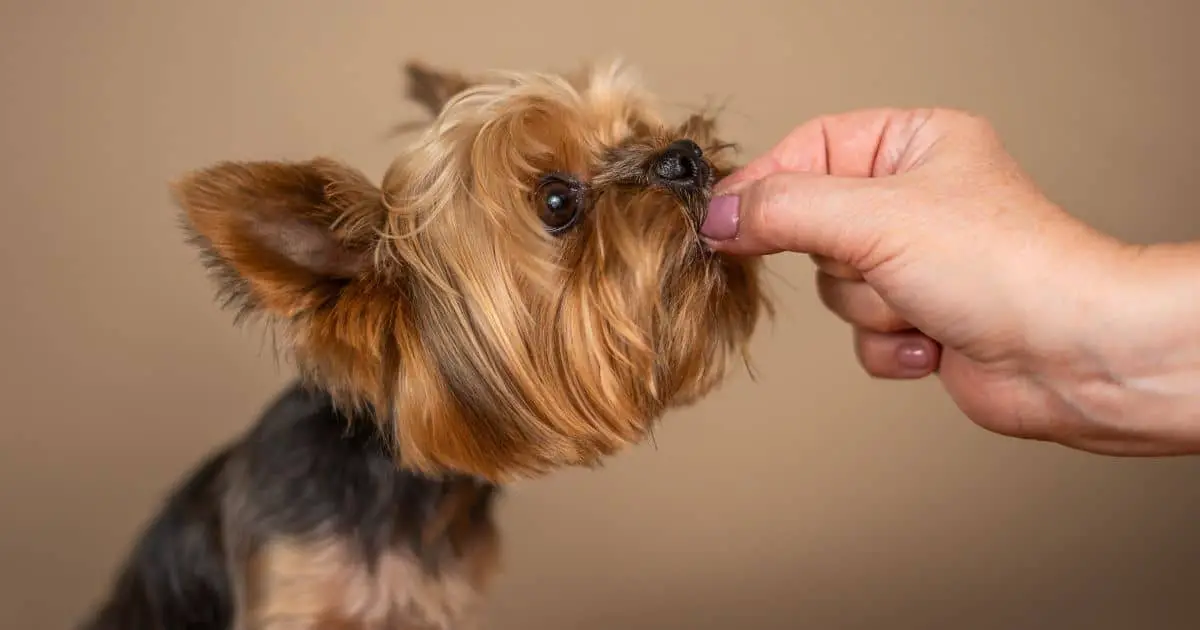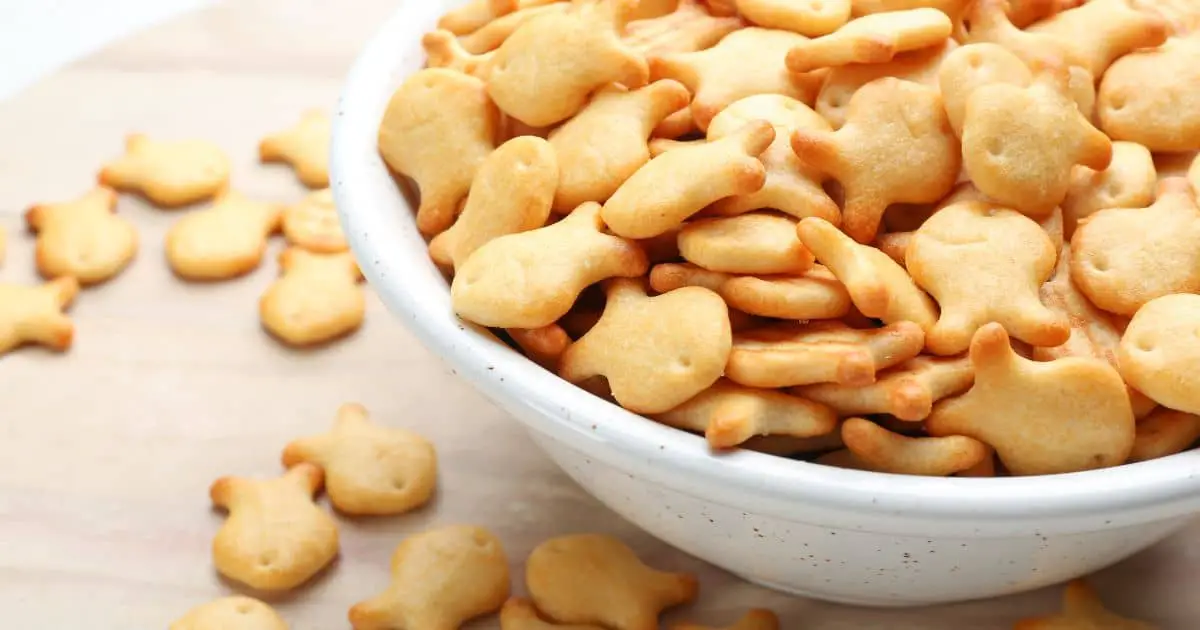One thing remains consistent whether you have one furry friend or an entire pack. You want to give your pets the best! Because you love them so much, you might want to share human snacks like goldfish crackers with your canine friend.
Sure, goldfish crackers are a nice, crunchy snack. But can dogs eat goldfish crackers? If you give your dog goldfish crackers, how might that affect them?
All of these are important questions that pet owners should know before giving in to their dog’s food begging. In this article, we’ll be taking a closer look at goldfish crackers to see if they’re truly a healthy and acceptable snack for your furry darling.
Enjoy!
Can Dogs Eat Goldfish Crackers?

Yes, dogs can eat goldfish crackers. These snacks aren’t great alternative food options, though. This is because they don’t offer your pet any natural nutrients. On the other hand, they won’t induce negative health effects in your canine companion either.
That being said, not every goldfish cracker snack can be fed to your pet. The main reason for this is that a few brands of these tasty snacks contain bad ingredients that can cause very harmful effects.
So, while these can be used as a treat if carefully chosen, the potential health risk of accidentally picking a brand with the wrong ingredient options means that you’re better off looking for safer and better commercial treats for your dog.
Everything You Need to Know About Feeding Goldfish Crackers to Your Canine
A staple snack for adults and children alike, these tasty crackers are always a joy to have. While they are a great snack for humans, we don’t recommend that you offer goldfish crackers to your canine companion. This is mainly because not all the snacks in this category are suitable for their consumption.
Whether goldfish crackers are a good snack for dogs is dependent on the type of goldfish crackers you have at hand. Goldfish crackers can be divided into two groups categorized according to their health effects on canines.
Canine-Friendly Goldfish Crackers
This is the type of goldfish that is made using the traditional recipe. It doesn’t matter whether the crunchy snack is from a brand or an off-brand source.
The ingredient label of these crunchy nibbles shows that they contain elements common in many human foods like salt, fat, and other artificial flavors. This recipe excludes ingredients like fresh garlic or onion powder.
In small servings, these types of goldfish treats are considered canine-friendly food because they don’t have a bad ingredient list. Even so, it is important to remember that they don’t offer your dog any beneficial nutrition, so they are not a substitute for nutritious dog food.
Non-Canine-Friendly Goldfish Crackers
The crackers in this category taste just like any other food for humans to us. Again, they could be from a name brand like Pepperidge Farm or an off-brand source.
What distinguishes these from their dog-safe counterparts is the addition of ingredients like roasted garlic, onion powder, garlic salt, onion salt, and other potent artificial flavors. These are all toxic ingredients that can put your furry friend in harm’s way.
Consumption of this type of goldfish saltine cracker by your canine companion is almost guaranteed to result in an emergency visit to the veterinary hospital!
Choosing the Right Type of Goldfish Cracker for Your Pet

We have established that dogs can eat goldfish crackers made with the traditional recipe. You have to be sure that there are no harmful additives, though.
If you want to feed your dog goldfish crackers, you will need to come up with a foolproof way to select a crunchy snack that your pet can safely enjoy in this category.
While that sounds like a simple task, the truth is that it can be unbelievably challenging to distinguish between canine-friendly and non-canine-friendly goldfish crackers.
A decent approach here would be to ensure that you check the ingredient label every time you purchase these items and share these snack crackers sparingly with your pet.
If you want to be on the safe side and truly ensure the health and well-being of your dog, we strongly recommend that you stop sharing this treat with your dog altogether.
We say this because even if you’re meticulous and check for bad ingredients every time you go shopping, there’s always the possibility that the manufacturing company will change ingredients without making it obvious.
This seemingly insignificant change can be enough to trigger adverse side effects in your pet. As such, it may be better to treat all the different kinds of snacks in this category as dangerous junk food for your dog.
Dog Health: Harmful Ingredients in Goldfish Crackers to Watch Out For
Goldfish crackers can contain a long list of ingredients harmful to your canine family. Here, we’ll be touching on the most common ones found in the recipe for the original cheddar snack.
The complete ingredient list includes salt, garlic salt, onion salt, onion powder, and garlic powder.
Even in minute quantities, garlic and onions are capable of hurting your beloved pet. The main reason for this is that, in most cases, onion and garlic seasonings are manufactured to be more potent than real-life garlic cloves and medium-sized onion cuts themselves.
This increase in concentration is supposed to ensure that consumers can truly savor the taste of their salty snacks. Unfortunately, it also enhances the health risk that a dog is exposed to if they consume these treats.
It should be noted that the buildup of sodium and other toxic elements in your pet is directly dependent on factors like the size, breed, and sensitivity of your dog. In many cases, this means that a small portion of goldfish crackers can be enough to trigger sodium-ion poisoning and other health conditions.
What makes this situation particularly tricky is that your dog could be struggling with sodium poisoning and you wouldn’t even be able to tell, at first. It’s only when things have progressed to truly dangerous levels that some dogs start to present obvious symptoms.
Given that the level of salt content in this baked snack is high even by human standards, giving your dog these tasty treats only increases the chance of them suffering salt toxicity.
Adverse Effects of Goldfish Cracker on Canines
Things can go in very different directions if a dog consumes these salt crackers.
Now, assuming we’re dealing with a medium-sized dog with an average natural sensitivity level that had no more than three goldfish saltine crackers, you should anticipate little more than mild diarrhea and/or a small case of indigestion.
The severity of this incident will typically be considerably lesser with larger breeds as the level of salt toxicity will be tempered because it’ll be traveling through a wider body area. In the same vein, you can expect the distress to be more severe in smaller breeds because they possess a smaller body mass.
It’s also possible for negative health effects to present themselves more prominently, regardless of other outlying factors. In these instances, the first signs of discomfort in your dog will likely be visible within the first 6 hours of eating these salty foods.
Breathing difficulties, extreme dehydration, severe diarrhea, and anemia in dogs are some of the most common symptoms observed. Vomiting and severe lethargy can also be expected.
There may also be pale coloring around the eyes and nose of the canine as well. Due to rapid breathing and excess dehydration, many dogs also start to release dark-colored urine.
All of these are clear symptoms of dog poisoning by allium family spices. As canines react strongly to these spices, you have to get your pet to the nearest emergency vet quickly. If this situation isn’t addressed quickly, it’s been known to result in mortality. So, the stakes are pretty high here.
Steps to Take if Your Dog Has Had Goldfish Snacks

You step out to use the bathroom for a moment and come back to meet an empty bowl of your tasty snacks. The dog has eaten it all! Should this happen, here are five steps you can take to handle the situation decisively.
Step One: Check the Ingredient Label
While it might be hard to do otherwise, we urge that you not panic and keep yourself calm and collected. This is because you must analyze the situation carefully so that you can take all necessary actions promptly.
So, the first thing you need to do here is to know just what it is you’re dealing with. This means going over the ingredient list of the goldfish crackers. The information you find there will give you a clue as to whether what your dog ate is in the canine-friendly category or not.
While going over the goldfish cracker’s nutrition facts, be sure to check for the presence of allium family spices. Also, note the exact levels of salt that the snack carries.
Step Two: Figure Out How Much the Dog Has Had
The next thing you need to know is how much of the crunchy snack your dog has eaten. This knowledge will give you a good hint as to how much salt content and other harmful ingredients are coursing through their system.
Figuring this out as accurately as possible will let you know whether what they’ve had to eat is sufficient to cause mild or severe poisoning.
Once you’ve made an educated guess here, push up that number a bit. When it comes to dealing with incidents of toxicity, it’s always better to overestimate rather than underestimate the gravity of the problem. Doing so will let you address the situation more thoroughly.
Step Three: Contact Your Veterinary Doctor
You’ve taken stock of the condition and you now have the facts. The next thing you have to do is get in touch with a medical professional. Contact your veterinary doctor and apprise them of the situation.
Depending on what you’ve said, the vet will either ask you to bring your canine companion in immediately or keep them with you for the time being and watch for symptoms.
If you’ve been asked to do the latter, we suggest that you check with the doctor to know whether or not you can feed your pet a bland diet in the meantime. Getting your vet’s thoughts on this is great because a bland diet can help calm your pet’s upset stomach.
A bland diet is superior to a regular diet in this regard because it fosters faster digestion of salt and fatty acids.
Step Four: Watch For Symptoms
This is where you have to be on guard. As we mentioned earlier, the symptoms of poisoning due to blood sugar issues, high sodium levels, and other toxic elements can be hidden at first.
But they’re considerably easier to spot if you’re on the lookout for them from the get-go.
For emphasis, you can’t afford to take chances here. This is not one of those cases where you should wait until you see two or three definitive symptoms before rushing to the vet.
The moment you observe unusual behavior like rapid or shallow breathing, tiredness, or vomiting, you’re already on a clock. Make sure you get them medical assistance as quickly as possible.
Step Five: Act Decisively
Indeed, veterinary services can cost a fortune today. Also, there’s the possibility that the symptoms of onion poisoning that your pet is displaying aren’t life-threatening and will go away on their own.
But do you really want to take that chance?
The main problem with taking this kind of risk is that, if you’re wrong, you may not be able to get help in time before the worst happens.
As long as you’re sure that your dog ate the crackers, you need to act and act fast once you notice any symptoms.
Conclusion
Finally, can dogs eat goldfish crackers?
Yes, dogs can eat canine-friendly goldfish crackers, but feeding these to your pet can be pointless as it offers no extra nutrient boost or additional vitamins.
Non-canine-friendly goldfish snacks on the other hand are downright poisonous and could end up killing your beloved companion.
So, ensure that you know which is which before exposing your dog to this treat, and watch the pet closely so you can act quickly if any issues arise.
See more great tips on proper dog care here.
